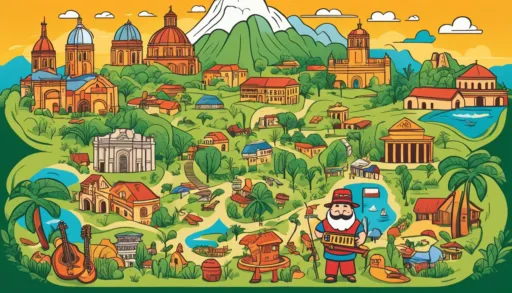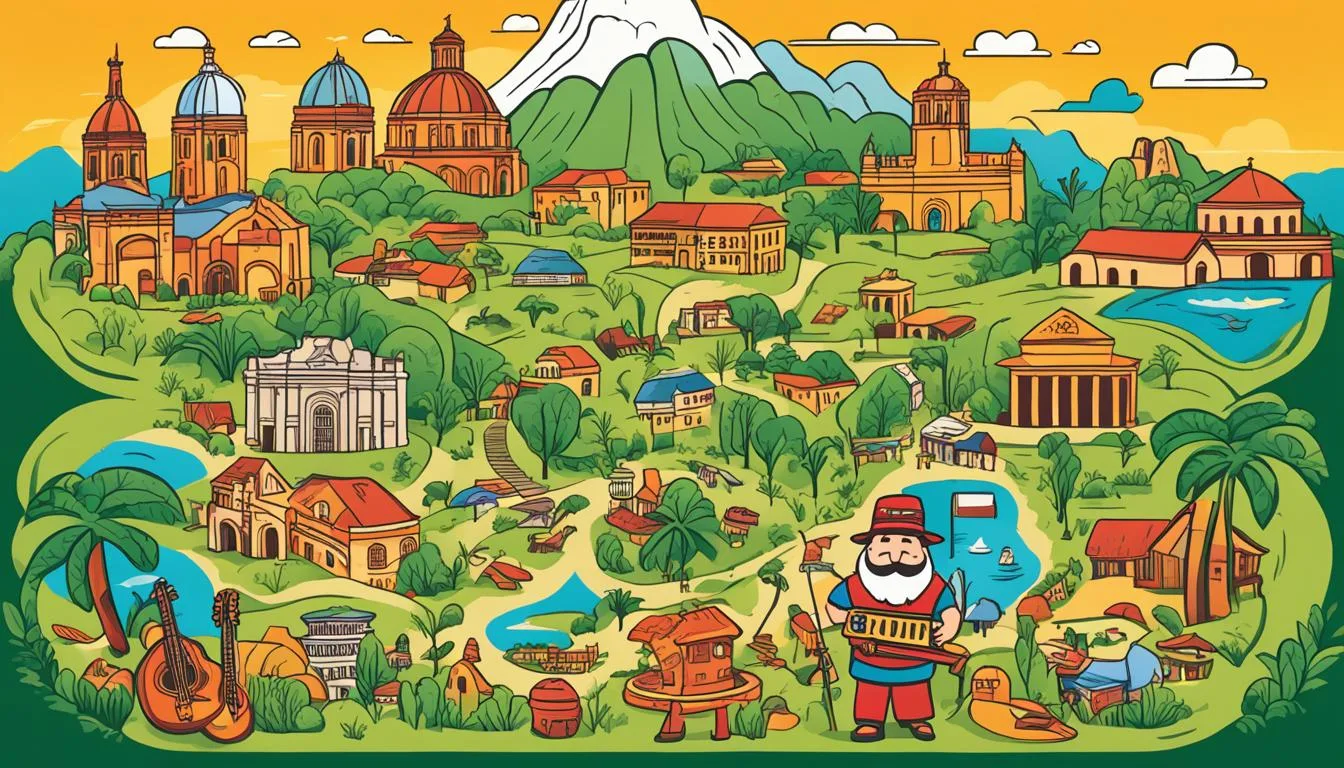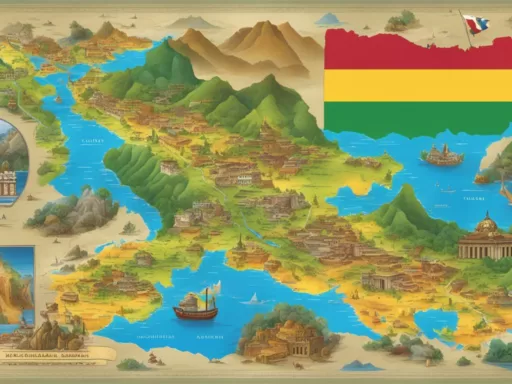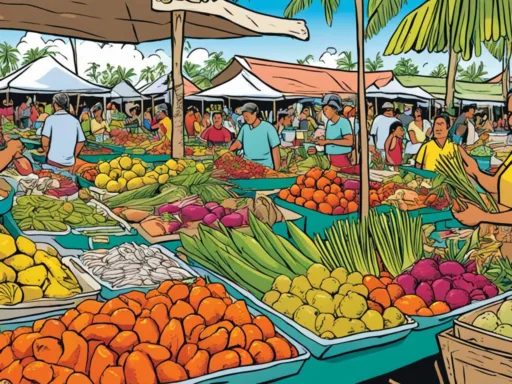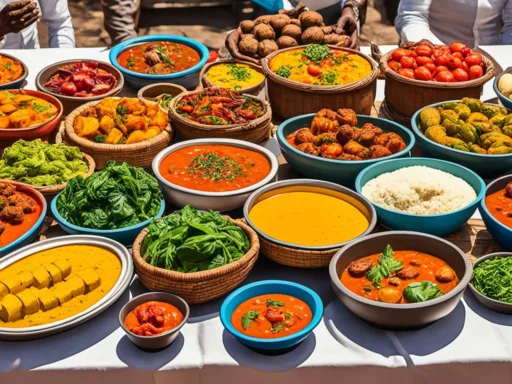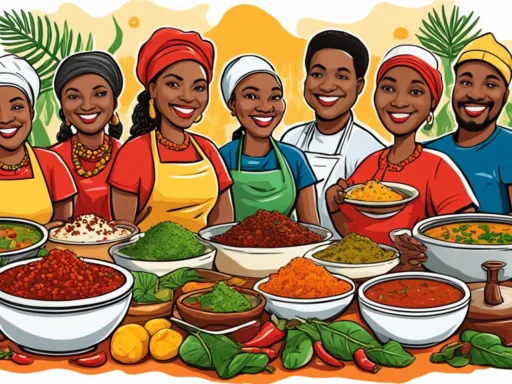While many countries around the globe boast linguistically diverse populations, few can claim a national identity as deeply intertwined with their linguistic landscape as Paraguay, where **77%** of the population understands an indigenous language. This surprising figure sheds light on the intricate weave of languages spoken in Paraguay, a place where its residents navigate daily life through a rich cultural identity shaped by both Spanish and Guaraní. The South American nation’s unique linguistic tapestry not only captivates with its blend of official languages but also with an array of indigenous dialects, each carrying the ancestral wisdom of its people.
Key Takeaways
- The nation’s cultural identity is profoundly influenced by the bilingual nature of Spanish and Guaraní.
- Paraguay showcases a unique linguistic tapestry, differentiating it from other South American countries.
- The prevalence of Guaraní among non-indigenous Paraguayans is a testament to its integral role in society.
- A multitude of indigenous languages enrich Paraguay’s linguistic diversity beyond its two official tongues.
- Understanding the dynamics of the languages spoken in Paraguay offers a window into its history and societal values.
A Linguistic Overview of Paraguay
The rich tapestry of bilingual Paraguay is a vibrant reflection of its multi-ethnic roots, juxtaposing the age-old traditions of the Guaraní culture with the widespread use of Paraguayan Spanish. This remarkable linguistic confluence has been constitutionally recognized since 1992, making this South American nation a study in harmonious language coexistence and fluid bilingual communication.
The Bilingual Nature of the Country
In Paraguay, threading through every aspect of daily life is the profound bilingual nature of its language demographics. Remarkably, a significant numbers of Paraguayans seamlessly weave between Spanish and Guaraní, often mixing them in a colloquial dialect known as Jopara. This pidgin form, serving as a linguistic bridge, not only simplifies communication among the Paraguayan people but also exhibits the practical embodiment of their rich linguistic identity.
The Influence of the Guarani Culture on Language
The Guaraní language, stalwart in its cultural influence, reverberates beyond the indigenous communities to be spoken by a wide, diverse audience including non-indigenous Paraguayans. This unique aspect of Paraguay language demographics serves as a testament to the profound impact of Guaraní on the country’s identity. The enduring presence of Guaraní alongside Spanish demonstrates its pivotal role in shaping the nation’s social and cultural dialogues.
Official Languages of Paraguay: Spanish and Guarani
The cultural and communicative landscape of Paraguay is distinguished by its two official languages: the Spanish language and the Guaraní language. These linguistic powerhouses coexist within the nation, offering a rare glimpse into a world where indigenous and European languages not only share official status but also the hearts and daily lives of the Paraguayan people.
The Spanish language, widely used in official domains such as government and education, offers a bridge connecting Paraguay to the global Spanish-speaking community. It’s used in formal settings and serves as the groundwork for many of the nation’s official policies. Despite its official capacity, Spanish also flourishes in the media, further cementing its role in the national conversation.
On the other side of the linguistic coin rests the Guaraní language, whose presence is felt intensely in more personal facets of Paraguayan life. It’s a language spoken at home, in the streets, and in the hearts of the population. Guaraní is not just retained for cultural heritage; it’s alive, breathing vibrancy into everyday interactions. The Guaraní Academy ensures that the language’s purity and essence are preserved, regulating its use and advocating for its continued relevance in modern society.
These languages, while given the same official status, reveal a complex societal fabric molded by a deep-seated diglossia. This phenomenon shapes the way in which official languages Paraguay are practiced, often with certain dialects or variants selected over others depending on the setting. The dynamic between Spanish and Guaraní in Paraguay is a fascinating dance of culture, identity, and linguistics, unparalleled in the region.
The Guaraní Academy plays a pivotal role in maintaining the linguistic integrity of one of Paraguay’s most treasured assets, the Guaraní language.
| Language | Usage Context | Supported By |
|---|---|---|
| Spanish Language | Government, Education, Media | National Policies |
| Guaraní Language | Home, Informal Settings | Guaraní Academy |
This blend of the Spanish and Guaraní languages not only represents the surface dichotomy of official functions and everyday speech but also the profound interweaving of different cultural threads to create a tapestry uniquely Paraguayan.
Languages Spoken Paraguay: The Indigenous Languages
Within the rich cultural weave of Paraguay lies a tapestry of indigenous languages, each thread contributing to the nation’s vibrant heritage. Beyond the widespread use of Spanish and Guaraní, a multitude of native tongues, spoken by communities large and small, preserve the traditions and histories of the Paraguayan indigenous populations. These languages, from Aché to Toba Qom, are not merely means of communication but also serve as vessels for ancestral knowledge and cultural identity.
From Aché to Toba Qom: Preserving Indigenous Heritage
Language preservation in Paraguay is a crucial aspect of maintaining the unique identity of each indigenous community. The country’s commitment to safeguarding these languages is evident through various cultural initiatives and educational efforts. The intrinsic value of such diverse linguistic expression is a nod to the past, a bridge to the present, and a gateway to the future for indigenous heritage.
The Role of Language in Indigenous Communities
For the indigenous peoples of Paraguay, language is the heartbeat of their communities. It shapes social structures, informs cultural practices, and imparts a sense of belonging. The transmission of stories, customs, and beliefs through these indigenous languages ensures that generations to come will continue to celebrate and live the heritage that has been passed down to them.
It is estimated that around 50,000 Paraguayans are keepers of these ancestral tongues. The continued use of languages such as Iyo’wujwa Chorote and Maka is not only a testament to the resilience of these communities but also a reminder of the ongoing efforts required for language preservation. The conservation and revitalization of these linguistic gems stand as a focal point for cultural and academic discussions on indigenous heritage in Paraguay.
Paraguay’s Language Demographics: Trends and Statistics
Exploring the Paraguay language demographics unveils a landscape rich in linguistic diversity shaped by historical contexts and modern-day influences. Through current data, we can discern the nuances of urban vs. rural language use and witness how language proficiency shifts are playing out across generations.
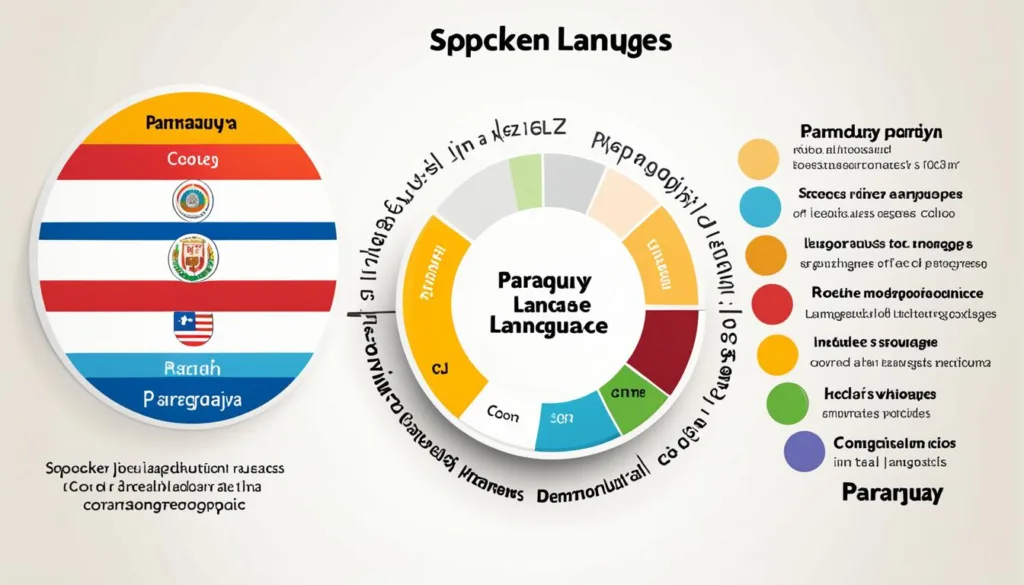
Language Distribution in Urban vs. Rural Areas
In Paraguay’s pulsating urban centers like Asunción, the Spanish language boasts a widespread presence, serving as the go-to mode of communication in business, education, and media. However, a journey into more bucolic landscapes such as San Pedro presents a different story, where the Guaraní language blooms amidst the local populace, preserving the essence of rural life through every conversation and cultural expression.
The Shifts in Language Proficiency Over Time
The generational evolution in language proficiency is particularly striking with the youth showing an increasing proclivity towards Spanish, a trend more pronounced in city landscapes as they integrate into the global economy and an interconnected world. Yet, amidst this linguistic ebb and flow, the two tongues of Spanish and Guaraní remain interwoven in the fabric of Paraguayan society, presenting a bilingual mosaic unique to this nation.
Guarani: The Heart of Paraguay’s Linguistic Identity
In the realm of linguistic identities, the Guaraní language emerges as the lifeblood of Paraguayan culture, shaping the social tapestry of this vibrant nation. Its prevalence is not only a matter of daily communication but also of cultural significance, resonating deeply within both indigenous and non-indigenous communities. It stands as a testament to Paraguay’s commitment to language diversity and a reflection of modern Paraguayan society’s rich history.
The Rarity of Guaraní in the American Linguistic Landscape
The distinction of Guaraní within the American continent’s language diversity is remarkable. Unlike other indigenous languages of the Americas that often find their speakership limited, Guaraní breaks this pattern by maintaining its significance across different social strata in Paraguay. This unique linguistic phenomenon underscores the resilience and continued relevance of an ancient tongue in a modern world.
Guaraní’s Influence on Modern Paraguayan Society
Guaraní is not merely about words and grammar; it is the medium through which Paraguayans express their cultural identity, preserve traditions, and continue to shape a collective national consciousness. Its influence extends beyond oration, as it is inherently woven into the arts, music, and even the very expressions used by Paraguayans to interact with one another in their day-to-day life. The language’s vibrancy and adaptability reinforce its integral role in the nation’s cultural fabric and the pride of its people.
As we delve into the heart of Paraguay’s linguistic essence, we recognize the indispensable value of fostering such rich cultural heritage. Guaraní’s interaction with the forces of modernity paves the way for a society that cherishes its roots while gracefully embracing the future.
Language Diversity Paraguay: Anomaly of Non-Indigenous Guarani Speakers
In Paraguay’s rich tapestry of languages, one finds quite a remarkable phenomenon: a significant number of non-indigenous Guaraní speakers. Unlike other regions in the Americas with a dominant presence of European colonial tongues, these mestizos—or mixed ancestry individuals—have maintained the indigenous language of Guaraní vigorously within their communities. Such unique linguistic diversity in Paraguay can be attributed to several historical and social dynamics.
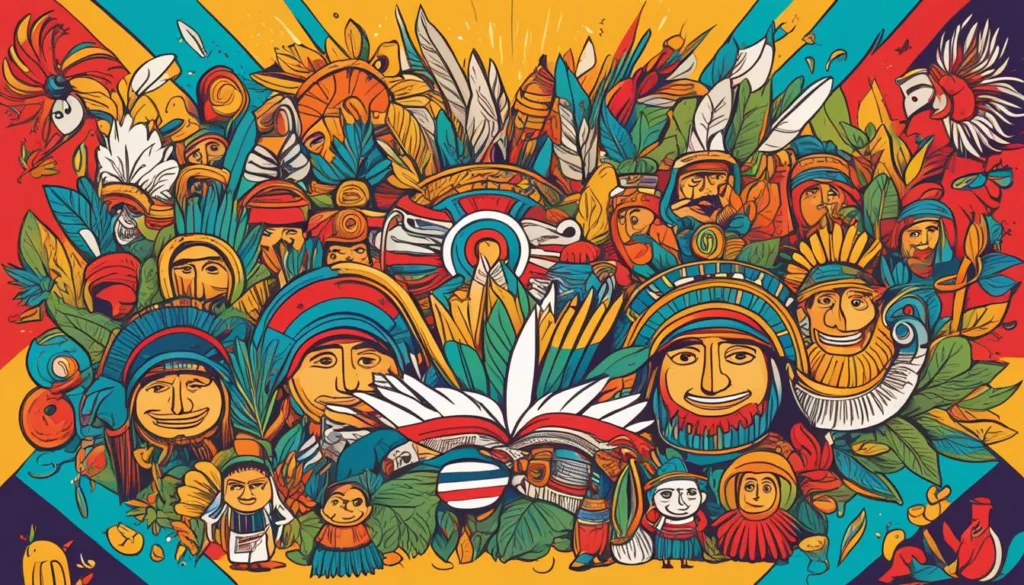
The cultural fabric of Paraguay is interwoven with the threads of its matriarchal past, where mixed-race families often embraced the Guaraní language as a central part of their daily life. This contrasts with the experience of many other nations in the Americas. The steadfast resilience of Guaraní among mestizos is a testament to the complex interplay between ethnic identity and language in the region.
| Demographic Group | Percentage Speaking Guaraní | Relevance to Socio-Historical Factors |
|---|---|---|
| Indigenous Population | Approximately 95% | Intrinsic linguistic and cultural preservation |
| Non-Indigenous Population | Over 50% | Reflective of unique historical conditions favoring the preservation of indigenous languages |
| Mestizo Population | Varies with region | Illustration of language retention within mestizo identity |
These socio-historical undercurrents have facilitated an environment where language diversity in Paraguay is celebrated and Guaraní is spoken with pride, not only amongst those with pure indigenous lineage but also within the broad spectrum of mestizos. This multifaceted language scene ascribes a particular charm to Paraguay’s linguistic landscape, one that calls attention to the sheer resilience and affection for a native tongue in the face of globalization’s homogenizing influence.
Popular Languages in Paraguay Beyond the Official
While Spanish and Guaraní dominate the linguistic landscape of Paraguay, the nation’s multicultural fabric is enriched by a tapestry of languages introduced by its diverse immigrant communities. In the heart of South America, these languages represent the pivotal influence of migration patterns and cross-cultural exchange that have shaped modern Paraguayan society.
The Presence of German, Portuguese, and Other Languages
Paraguay’s language panorama is dotted with European and regional accents, as immigrant communities maintain their native tongues. Particularly, the Portuguese language resonates near the Brazil-Paraguay border, illustrating the porous linguistic interchanges that typify frontier zones. Moreover, the German language, especially the dialect known as Plautdietsch, reverberates through the streets of Mennonite colonies, marking a distinctive linguistic enclave within the country.
Language Use Among Paraguay’s Immigrant Communities
Examining the language use among immigrant communities provides a window into Paraguay’s cosmopolitan character. The interplay of languages beyond the official Spanish and Guaraní highlights the broader context of Paraguay language use, with a varied spectrum of tongues being spoken, preserved, and celebrated across the nation. To detail the prevalence of these languages, the following table encapsulates the rich linguistic diversity brought forth by immigration.
| Immigrant Language | Origin Country | Community Size | Common Usage |
|---|---|---|---|
| Portuguese | Brazil | Large | Trade, Daily Communication |
| Plautdietsch | Mennonite Communities | Significant | Religious Services, Education |
| Italian | Italy | Medium | Cultural Events, Family Gatherings |
| Other European Languages | Various | Small | Intercultural Exchange |
The Phenomenon of Jopara: A Blend of Spanish and Guarani
When you stroll through the streets of Paraguay, the air is filled with an intricate dance of phonetics and vocabulary, painting a vivid linguistic landscape. This is largely due to Jopara, an intriguing social phenomenon that goes beyond mere words; it’s the very embodiment of Paraguayan cultural synergy. The term itself – Jopara – is a Guaraní word meaning “mixture,” and that’s precisely what this linguistic concoction is, marrying the indigenous Guaraní with the colonial Spanish into a blend that might remind speakers of other languages of Spanglish, yet it retains its unique Paraguayan essence.
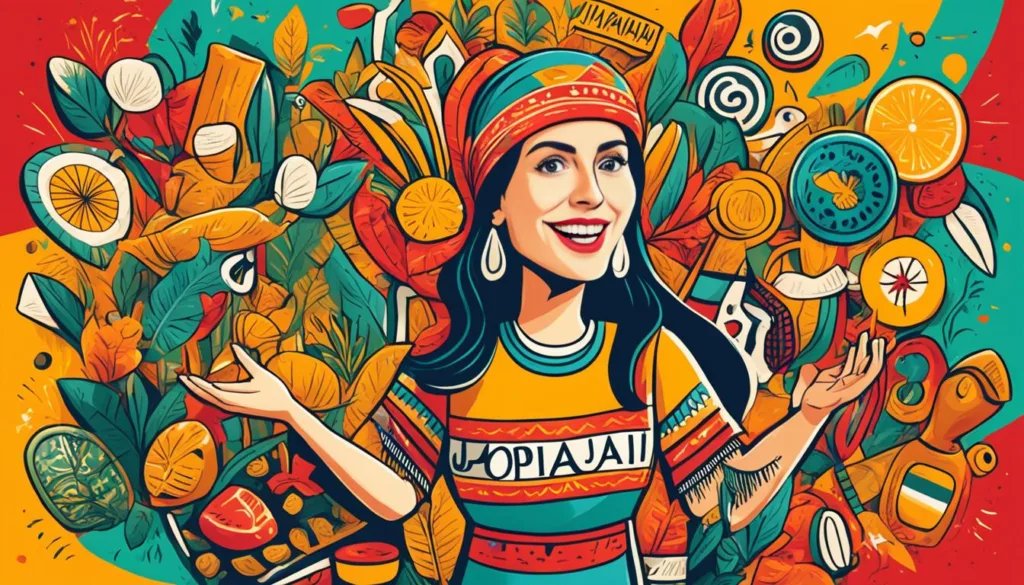
Unlike the often-cited Spanglish, which predominates certain urban Latino communities in the United States, Jopara flows within the heart of Paraguay’s society. It’s not limited to casual conversation; instead, it can be found in literature, media broadcasts, and parliament speeches, signifying its status as a cornerstone of the national identity. Jopara represents something deeply ingrained in the Paraguayan psyche, a bridge between two worlds that have coalesced to form the country’s sociolinguistic fabric.
Despite not being formally recognized as its own language, the use of Jopara tells the story of a people who wear their heritage proudly, interweaving their pre-colonial roots with their present lives. The key to understanding Paraguay’s complex societal structure is listening to the rhythm of this Spanish-Guarani blend, which resonates with the heartbeat of its people.
The interlacing of Spanish and Guaraní into Jopara doesn’t only surface in vocabulary but also in grammatical structures, phonology, and even in the very ethos of communication among Paraguayans. The natural ease with which they switch between the languages or blend them is a testament to the fluidity of their bilingualism, one that shapes community bonds and individual identities.
Intriguingly, Jopara isn’t static but a dynamic, living tapestry, continuously shaped by the interactions between speakers, much like any vibrant language. It embraces new terms, adapts to contemporary contexts, and yet, it inherently remains deeply rooted to Paraguay’s soil and soul, guarding both the ancient and the current chapters of its story.
Indigenous Languages Paraguay: Vitality and Challenges
The cultural tapestry of Paraguay is richly woven with a variety of indigenous languages that are emblematic of the nation’s heritage. These languages carry more than mere communication—they are a conduit of traditions, beliefs, and histories. Yet, their existence is threatened by the rapid pace of globalization and the onslaught of a digitally-dominated era. The collective effort to sustain and revitalize these languages is of paramount importance, engaging not only communities but also influencing national education policies and language initiatives.
Safeguarding the Lesser Spoken Tongues
Indigenous languages in Paraguay, such as Aché, Ayoreo, and Sanapaná, represent vulnerable threads in the cultural fabric of the country. It’s essential to bolster these languages against the tide of language shift as they face the danger of being lost to future generations. Revival strategies are being designed to maintain the linguistic diversity that is so important to Paraguay’s national identity. This includes recording, teaching, and ensuring these languages continue in public life where possible.
Language Initiatives and Education Policies
Language initiatives with an aim to incorporate indigenous languages into Paraguay’s broader educational curriculum are at the forefront of preserving linguistic heritage. Education policies tailored to the unique cultural context of Paraguay are crucial, offering an approach that integrates these indigenous languages within mainstream education. With a dual emphasis on language as both a formal subject and a medium of instruction, these policies encourage active usage and foster a supportive environment for linguistic longevity.
Moreover, classroom resources include bilingual textbooks and materials that are necessary to support these initiatives. Workshops and teacher training programs are also integral to ensuring that the educators themselves are well-equipped to guide and inspire students in both urban and rural settings.
Conclusion
In examining the rich tapestry of languages that form Paraguay’s communicative landscape, we look forward to the future of language diversity in Paraguay. This nation’s multilingual heritage goes beyond mere communication—it is an embodiment of a cultural identity, intimately woven into the social fabric of its people. As global influences continue to shape local cultures, it is imperative to maintain the delicate balance between preserving traditional languages and embracing inevitable change.
The Future of Language Diversity in Paraguay
The sustainability of Paraguay’s linguistic variety hinges on purposeful action. Education systems that promote language learning, policies that protect linguistic rights, and community support for native speakers are all pivotal in securing a diverse linguistic landscape. The resilience of indigenous languages, alongside the predominance of Spanish and Guaraní, will depend largely on these collective commitments to value and preserve this precious aspect of Paraguayan society.
Appreciating Paraguay’s Multilingual Heritage
Embracing Paraguay’s multilingual heritage is not merely about cultural pride but also about societal enrichment. Acknowledging the vast array of languages spoken in Paraguay is the first step; actively engaging in their preservation and evolution is the journey that lies ahead. As we appreciate the intricacies of each language, we affirm their roles in conveying history, shaping identities, and enriching lives—a multidimensional legacy worth upholding for future generations.
FAQ
What languages are spoken in Paraguay?
In Paraguay, the official languages are Spanish and Guaraní. Spanish is universally understood, and Guaraní is spoken by a significant portion of the population. Additionally, there are 19 indigenous languages spoken by various communities, and languages like Portuguese, German, and others from immigrant communities are also present.
Are people in Paraguay generally bilingual?
Yes, Paraguay is predominantly bilingual. Many Paraguayans speak both Spanish and Guaraní. This bilingualism is reflected in the use of Jopara, which is a mix of the two languages, and is often spoken in households across the country.
What roles do Spanish and Guarani play as the official languages of Paraguay?
Spanish is generally predominant in government, judicial processes, media, and education, while Guaraní is prevalently used in domestic and familiar settings. Both languages are officially supported and regulated, with Guaraní being notably overseen by the Academy of the Guaraní Language.
How are indigenous languages preserved in Paraguay?
Indigenous languages in Paraguay are preserved through community practices and language initiatives. Organizations work towards education policies and programs that support indigenous language learning and usage to ensure these languages continue to be passed down through generations.
What are the language demographics in urban versus rural areas of Paraguay?
Language use in Paraguay varies geographically. In urban areas, such as Asunción, Spanish is more prevalent, while in rural regions, such as San Pedro, Guaraní is more commonly spoken. There is also a notable trend toward increased Spanish use among younger generations, particularly in urban settings.
How unique is Guarani’s position among the languages of the Americas?
Guaraní holds a unique place as it is one of the few indigenous languages in the Americas spoken widely by both indigenous and non-indigenous populations. Its influence is emblematic of Paraguay’s linguistic identity, finding its place even in modern-day society.
Why is there a significant number of non-indigenous Guarani speakers in Paraguay?
Non-indigenous Guarani speakers are a result of Paraguay’s specific historical context, including lower rates of European migration and the sociocultural dynamics that favored the Guaraní language, such as matriarchal mixed-race families that promoted the language across generations.
Which languages are spoken by Paraguay’s immigrant communities?
Paraguay’s immigrant communities have brought a diverse range of languages including Portuguese, spoken near the Brazilian border, and Plautdietsch by Mennonite communities. Languages like Italian and German are also spoken by other immigrant groups, enriching Paraguay’s linguistic diversity.
What is Jopara and how does it reflect language use in Paraguay?
Jopara is not a language or dialect per se, but a blend or code-switching of Spanish and Guaraní. It reflects everyday language usage and is indicative of the cultural and linguistic convergence that characterizes Paraguay’s bilingual nature.
What are the challenges facing indigenous languages in Paraguay today?
Indigenous languages in Paraguay face challenges such as language shift and the pressures of globalization. Efforts are being made to safeguard these languages through various initiatives and educational policies aimed at promoting linguistic diversity and cultural identity.
What efforts are being made to ensure the future of language diversity in Paraguay?
To ensure the future of language diversity in Paraguay, efforts include educational reforms, language promotion initiatives, community-led programs, and legislative support to encourage the teaching and use of indigenous and official languages within the country.
